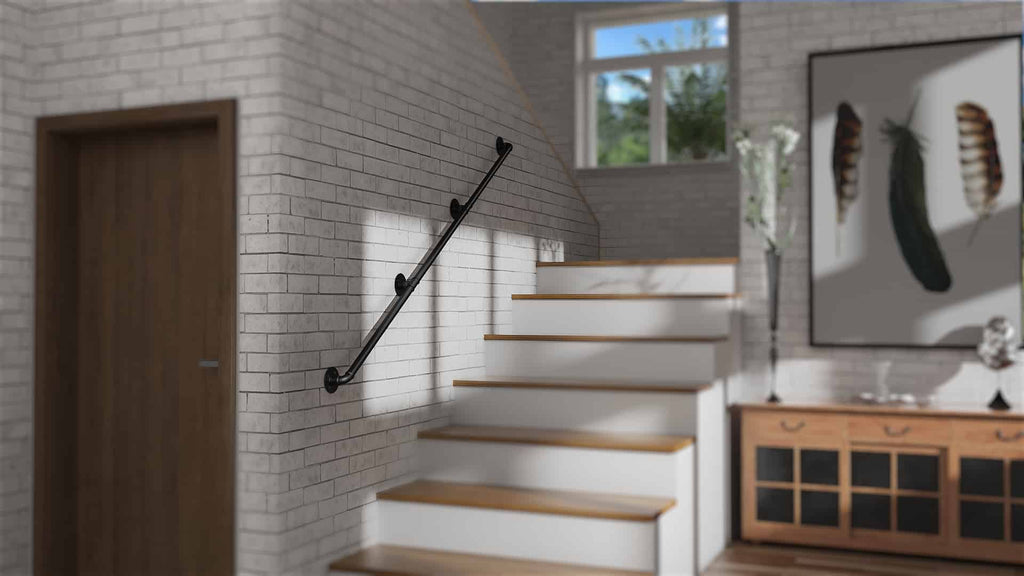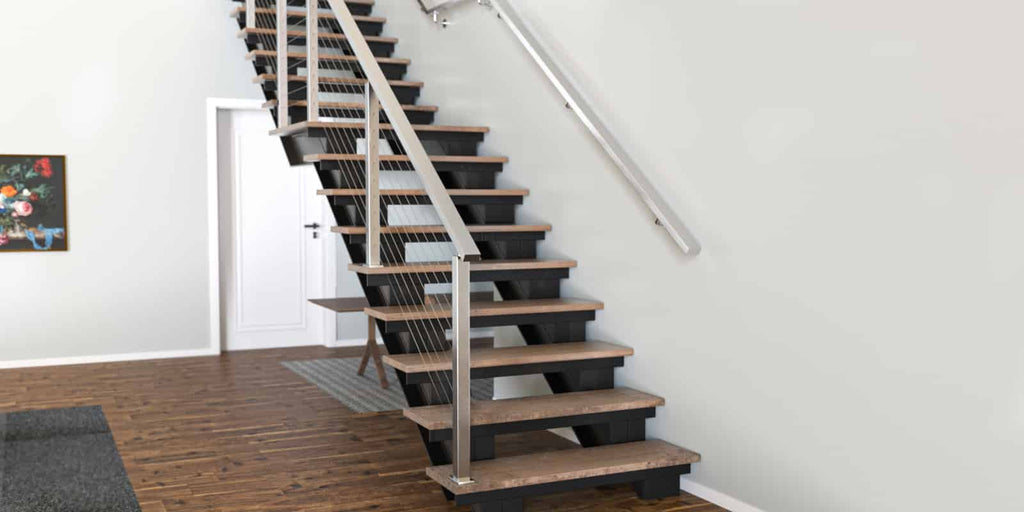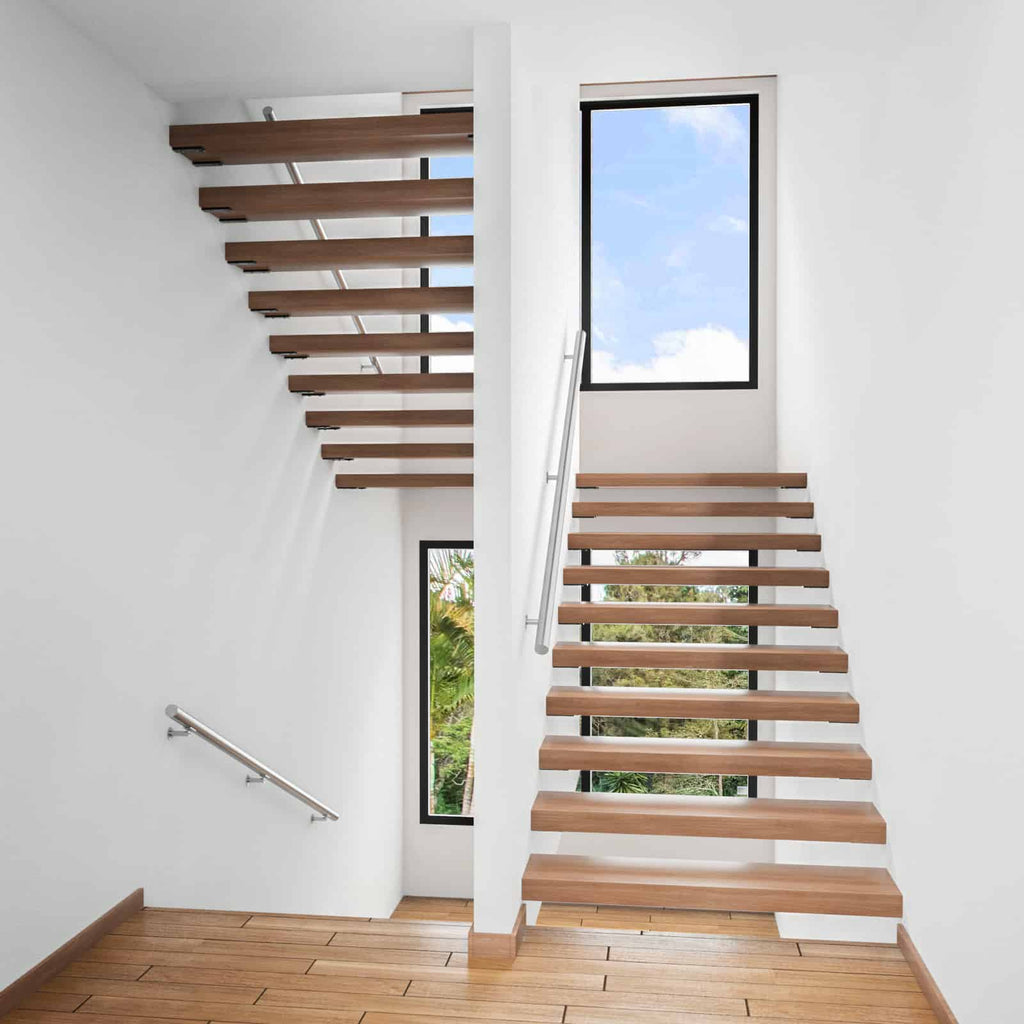TABLE OF CONTENTS
The Ultimate Guide to Choosing the Right Pipe Handrails for Your Property
Choosing the right handrails for your property is all about keeping things safe and looking good at the same time. Handrails are more than just something to hold onto as you climb stairs or walk on a ramp—they're also a chance to make your space look better. In this guide, we'll show you how to pick out handrails that are safe, meet the rules, and match your style without breaking the bank. Whether you want to do it yourself or get someone professional, we've got tips to help you choose materials, designs, and even colors that will make your property both safe and stylish. Let’s dive in and find the perfect handrails to complete your home or building.
What Are the Factors to Consider When Selecting Pipe Handrails?
When it's time to choose handrails for your property, there are several factors you want to weigh to ensure that the final decision is the right one. Let's walk through them.

Safety Requirements
- Stick to the Code: The safety of those using the handrails should be your top priority. This means you need to know your local building codes inside out because they'll specify the requirements for handrail height, strength, and even how far apart they can be spaced. These regulations are not just guidelines; they're rules you need to follow to make sure your property is safe and legally compliant.
-
Height and Strength Are Key: Make sure the handrails are at the right height so that children and adults can use them comfortably. They also need to be strong enough to support weight, which is crucial in case someone stumbles or needs to lean on them for support.
Durability and Maintenance Needs
- Weather Resistance: Think about the climate where your property is located. If it's exposed to lots of rain, snow, or salty air, you'll want materials that can stand up to those conditions without corroding or weakening over time.
- Maintenance Matters: Some materials may look great with little care, while others might need regular maintenance to keep them in tip-top shape. Stainless steel and aluminum usually require less upkeep compared to wrought iron, which might need occasional painting or rust treatment.
- Prepare for Wear and Tear: Consider the amount of use your handrails will get. In a busy commercial building, they’ll need to withstand a lot of wear and tear, whereas in a quiet residential building, they might not see as much action.
Aesthetic Preferences
- Matching Your Property's Style: Handrails should complement your property’s design aesthetic. Whether you’re going for a modern, industrial vibe or a more traditional, classic feel, picking handrails that align with this style is important for a cohesive look.
-
Finishes and Colors: With various finishes and colors available, you can choose handrails that either stand out as a feature or blend in subtly with the surroundings. It all depends on the statement you want to make.
Budget Constraints
- Weighing Costs vs. Value: While upfront costs are an important consideration, think about long-term value too. Cheaper materials might save money now but could cost more in maintenance or replacement down the line.
-
Material Price Differences: There is a broad range of pricing among different handrail materials. Metals like stainless steel tend to be at the higher end of the spectrum, while PVC and other plastics can be more budget-friendly options.
How to Measure and Plan for Installation
Once you've weighed all factors and picked out the perfect handrails, it's time to get into the nitty-gritty of installation preparation. Proper measurement and planning are essential here to ensure that your handrails fit just right and provide the safety and aesthetic appeal you're after.

- Enlist Expert Eyes: Getting a professional to assess your property can be incredibly helpful. They have the expertise to spot potential issues you might miss and can provide precise measurements. This isn't just about measuring lengths; it's also about considering angles, especially on staircases, and ensuring your handrails will meet all necessary safety standards once installed.
- Accuracy Leads to Safety: The accuracy of these measurements is crucial. If handrails are too high or too low, they won't provide adequate support, and if they're not correctly anchored, they could be unsafe. A professional will take all this into account, giving you peace of mind that your handrails will be as safe as they are stylish.
- Is It a DIY Job?: If you're handy and feeling confident, you might consider installing the handrails yourself. Before you do, though, realistically assess whether you have the tools and skills needed for the job. Remember, a mistake here could lead to more than just an aesthetic issue; it could compromise safety.
- Tools and Expertise Required: You'll need the right tools for the job, including drills, levels, and possibly specialized equipment depending on the material of your handrails. If you're not familiar with these tools, or if the thought of using them makes you nervous, it might be best to call in a pro.
How to Complement Your Property with the Right Handrail Design
Selecting the right pipe handrails for your property goes beyond functional safety and compliance; it's about enhancing the overall look and feel of your space. In this section, we'll dive into how you can ensure that the handrails you choose not only meet safety standards but also contribute to the aesthetic appeal and design harmony of your property.
Integrating Handrails into Existing Design
When introducing new elements to an existing design, the integration should be thoughtful and cohesive to maintain the property's architectural integrity.
- Color Matching: Choose handrails that match or complement the color scheme of your building. If exact matches are impossible, go for colors that blend in or provide a tasteful contrast.
- Style Consistency: The style of the handrail should align with the architectural style of your property—modern designs for contemporary buildings, and more intricate styles for classical architectures.
- Proportionality: Consider the scale of your property when picking handrails. Larger, more robust handrails can overwhelm a smaller space, while too slender rails may look insubstantial in a vast area.
- Continuity: If you're adding to an already-railing-equipped area, ensure the new handrails are identical or complementary to the existing ones to maintain continuity.
Customization Options
Customization can transform a standard handrail into a personalized feature that elevates the character of your property.
- Engravings: Engraving a company logo or family crest onto a handrail can add a unique and personal touch.
- Custom Colors: Powder coating offers the ability to match handrails to any color scheme, allowing for full integration into the property's palette.
- Unique Shapes and Patterns: Work with manufacturers that offer custom shapes or patterns that can make your handrails stand out.
- LED Lighting: Adding LED lighting underneath the handrail not only provides additional safety but can also create ambiance and highlight architectural features at night.
- Safety Enhancements: For added protection, especially in areas prone to slip-and-fall accidents, consider integrating textured grips or glow-in-the-dark strips.
By taking into account these customization options, you can ensure that your choice of pipe handrails adds to the distinctive appearance of your property, while still offering all the safety and functional benefits. This attention to detail can truly make a difference in creating a cohesive and welcoming environment for inhabitants and visitors alike.
How to Install Pipe Handrails
Installing pipe handrails is a critical step in ensuring the safety and durability of the handrail system. This overview provides a general step-by-step guide to the installation process while highlighting common mistakes to avoid for a smooth and successful project completion.

Step-by-Step Guide
- Site Assessment: Before anything else, perform a thorough assessment of the installation site. Identify any potential obstacles or special conditions that may affect the installation.
- Gathering Materials and Tools: Ensure all necessary materials (handrails, brackets, screws, etc.) and tools (drill, level, measuring tape, etc.) are on hand before starting the work.
- Marking the Layout: Using a chalk line or tape, mark where the handrails will go. This includes marking the locations for brackets or posts, and ensuring they are evenly spaced and aligned.
Main Installation Procedures
- Mounting Brackets or Posts: Depending on the type of handrail system, you'll either be installing brackets directly onto the wall or setting posts into the ground or floor. Use a level to ensure these are perfectly vertical or horizontal.
- Attaching the Handrails: Once the supports are secured, attach the handrails. For some systems, this might involve sliding the rail into place and securing it with screws. For others, welding might be required.
- Finishing Touches: Apply any finishes, such as paint or sealant, if not already done. Install end caps or decorative elements as needed. Finally, conduct a thorough inspection to ensure everything is secure and meets safety standards.
Common Mistakes to Avoid
The success of your handrail installation largely depends on avoiding these pitfalls:
Alignment Issues
- Failure to use a level during installation can result in uneven or slanted handrails, compromising both aesthetics and functionality.
- Incorrect spacing between brackets or posts can lead to instability or code compliance issues.
Inadequate Anchoring
- Using the wrong type of anchors for the material (concrete, brick, wood) can lead to loose handrails.
- Not drilling deep enough or using screws that are too short can also compromise the stability of the handrails.
Overlooking Details
- Neglecting to account for the expansion and contraction of materials, especially outdoors, can cause issues over time.
- Skipping finishing touches like sealants or rust protection, particularly in harsh weather conditions, can drastically shorten the lifespan of the handrails.
By following the outlined steps and steering clear of common installation errors, you can ensure that your pipe handrails are not only aesthetically pleasing but are also sturdy, safe, and compliant with local codes and regulations. Proper installation is crucial for maximizing the long-term value and effectiveness of your handrail system.
How to Source Your Pipe Handrails
Finding the right supplier for your pipe handrails is just as important as selecting the handrail type itself. This stage is crucial for ensuring quality, reliability, and compliance with legal standards. Below are strategies to help you source the best handrails for your project.

Finding Reputable Suppliers
Criteria for Selecting a Supplier
When choosing a supplier, consider the following criteria to gauge their reputation and reliability:
- Quality Certifications: Look for suppliers that have certifications like ISO 9001 which indicates that they adhere to international quality management standards.
- Product Range: A good supplier should offer a wide range of products and materials, providing options that suit different needs and preferences.
- Experience in the Industry: Established suppliers with a long history in the business are often more reliable and better understand the importance of code compliance.
- Customer Service: Suppliers who provide excellent customer service, including assistance with product selection and installation advice, can be invaluable.
- Warranty and After-Sales Support: A strong warranty and responsive after-sales support indicate that a supplier stands behind the quality of their products.
Importance of Quality Certifications
Certifications aren’t just paperwork; they represent a supplier's commitment to maintaining certain standards in their manufacturing processes and end products. They assure that the handrails are produced consistently and can withstand the conditions they’ll be subjected to.
Online vs. Local Shopping
Each method of shopping has its own benefits and drawbacks:
Online Shopping
- Pros: Greater convenience, typically broader selection, and sometimes better pricing due to lower overhead costs.
- Cons: Potential for misjudging quality without a physical sample, shipping costs for heavy items, and difficulty in returning products if necessary.
Local Shopping
- Pros: Ability to see and feel the product before buying, easier returns, and supporting local businesses.
- Cons: May be more expensive, limited inventory compared to online stores, and may require transportation for bulky items.
Ensuring Proper Specifications When Ordering
Whether ordering online or from a local shop, ensure that the specifications meet both your project’s requirements and regulatory standards:
- Detailed Descriptions: Obtain comprehensive product descriptions, including material specifications, dimensions, finishes, and any other pertinent details.
- Sample Requests: If ordering online, request samples where possible to confirm the quality and suitability of the handrails.
- Consultation Services: Utilize consultation services offered by suppliers to address any uncertainties regarding product capabilities and code compliance.
By carefully selecting a reputable supplier and considering the advantages and limitations of both online and local shopping, you can secure high-quality pipe handrails that satisfy all your project requirements. Taking the time to thoroughly vet potential suppliers can save you time and money in the long run while ensuring a successful installation.
Final Thoughts: Picking the Perfect Pipe Handrails for Safety and Style
Selecting the right pipe handrails is a crucial decision that blends safety, compliance, and aesthetics into one seamless choice. With the guidance from this article, you're set to make an informed selection that not only meets legal standards but also complements your property's style and ensures longevity. Remember, the right handrail is more than a safety feature; it's a statement piece that can elevate the functionality and appeal of your space for years to come.




